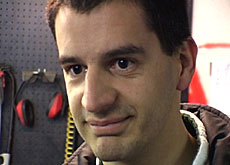Engineer plots path through minefield

Frédéric Guerne has been in the de-mining business since 1995, when he started working at the De-mining Technology Centre of Lausanne University.
This involved developing sensors for mine clearing, using high frequency radars to detect and bounce back images of mines.
But Guerne discovered that only low frequency radars could pick up objects buried beneath the ground. The signal bounced back was also too weak to accurately identify the object traced.
He then began to research the use of Nuclear Magnetic Resonance (NMR) for detecting TNT, one of the main ingredients of landmines.
He was able to develop a process which detected certain types of chemicals, but Guerne realised it could take a long time to perfect the technology to isolate TNT.
At this point Guerne met Michel Diot, the founder of FSD (the Swiss Federation for Mine Action), and showed him the results of his experiments.
Diot explained that what the de-mining staff really needed was immediate practical help in the field. Guerne realised that he had to start developing simpler, more mechanical solutions to mine-clearing problems.
Design process
The 33-year-old father-of-two started work on the design of the Digger in 1998.
The same year, he set up an association called Digger DTR (De-mining Technologies Research) with 35 members, including mechanics, electrical engineers, farmers and students.
A farmer living nearby allowed him to use his barn as a workshop, in which to build a prototype.
It cost a total of SFr150,000 ($103,750) to equip the workshop, then to design and build the machine. The money was donated by companies, private individuals, schools and local communities.
Three years later, Digger-1 emerged from the barn, ready for action. It underwent extensive testing in Switzerland before being transported to the Kosovo/Albanian border this autumn for testing in a minefield.
Digger-1 lived up to its promises and returned with hardly a scratch.
Funding shortfall
But Guerne says he is no longer able to work part time on this project – it has become too big and more funding is urgently needed.
Two university student friends have now started writing a business plan for Digger-2, otherwise known as Digger MCA (Mine Clearance Assistance).
Guerne is seeking funding for two salaried posts: one for himself and another for the mechanical engineer who will design Digger MCA.
Part of the plan is to rent out Digger-1 to mine-clearing organisations, providing two support staff to operate and maintain the vehicle during the period of deployment.
The machine would be delivered in a crate and assembled on location. The total package would cost SFr100,000 for three months.
Government interest
After the test drive in Kosovo, a team of Swiss parliamentarians came to inspect the vehicle, raising the possibility of government funding.
They were enthusiastic about the project and have agreed to provide a bigger workshop for the Digger MCA in Tavannes.
Guerne estimates that it will take months to set up the new workshop and over a year to design and build Digger MCA.
“I never dreamed when I started this project that it would take so long to achieve my goal, so long to get funding,” Guerne told swissinfo. “But we are all united in the belief that it will happen.”
swissinfo, Julie Hunt
The 1997 Mine Ban Treaty has been signed by 130 states.
Forty-eight nations remain outside its remit, including the US, Russia, China, India, Pakistan, Israel and Egypt.
Up to 20,000 people are killed or maimed by mines and unexploded ordinance every year.
The Swiss-made Digger promises to speed up mine-clearing work by 50 per cent and reduce casualties among de-mining staff by up to 80 per cent.
Frédéric Guerne, an electrical engineer from Courtelary in canton Bern, has spent three years developing a machine to help save the lives of de-mining personnel and enable them to work more efficiently.
The prototype Digger-1 has been tested in minefields in the Balkans and found to be highly effective.
But further development of Digger-1 is being hampered by a lack of funding.

In compliance with the JTI standards
More: SWI swissinfo.ch certified by the Journalism Trust Initiative









You can find an overview of ongoing debates with our journalists here . Please join us!
If you want to start a conversation about a topic raised in this article or want to report factual errors, email us at english@swissinfo.ch.